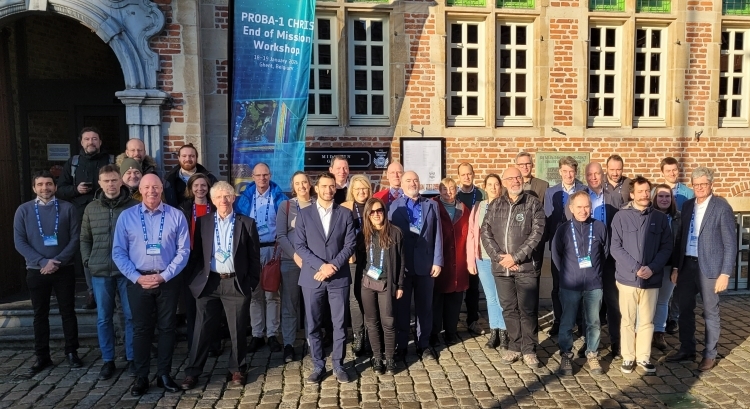Published on 21 February 2024
Scientists and data users gathered at a special workshop to celebrate the end of PROBA-1’s CHRIS sensor and discuss the results of this overachieving mission.
The Project for On-Board Autonomy, or PROBA-1, was ESA’s first small satellite, originally launched in 2001, to prove technologies in space. Intended to last only two-years, the mission exceeded expectations by acquiring over 21 years of hyperspectral data.
As its primary instrument, CHRIS (Compact High Resolution Imaging Spectrometer), recently ended operations, ESA’s PROBA-1 team gathered scientists and data users at a designated workshop to celebrate the journey of the mission and the impact of its long-term data series.

Celebrating the greatness of a small mission
The workshop took place on 18 and 19 January, in Ghent, Belgium, starting with general presentations about the evolution of the mission, followed by many impactful data use stories. The future of CHRIS data was also discussed, with attendees hearing about the success of recent cross-calibration campaigns and plans for subsequent reprocessing of the CHRIS archive.
There were hints of nostalgia when Surrey Satellite Technology Ltd (SSTL), who operated the mission jointly with ESA, recalled the submission of the CHRIS proposal, as long ago as 1997.
From its humble conception as an in-orbit technology demonstrator, after its launch in 2001, PROBA-1 went on to become a successful Earth observation mission, fuelling varied science, in applications ranging from disaster management and land classification, to the mapping of maize plant reflectance and bathymetry in turbid waters.
ESA’s Malcolm Davidson explained how the PROBA-1 CHRIS campaign helped spur a dramatic increase in data uptake from the scientific user community.
This user engagement supported the mission’s transition to ESA’s Third Party Mission (TPM) programme. While CHRIS ended its operational phase at the end of 2022, its data archive is available for free for research and data application development, via the TPM programme.
8,475 images over 957 global science sites
Due to the limited onboard resources of the small PROBA-1 payload, CHRIS data acquisition was restricted to two or three targets per day. These targets were carefully chosen to satisfy user requirements and respond to specific events, such as algal blooms.
During its lifetime, cloud-free science image acquisitions reached an impressive count of 8,473, following requests from 279 principal investigators between 2002 and 2022. In total there were 957 science sites globally, with the agricultural site in Barrax, Spain, being the longest standing.
Representatives from the user community also presented at the workshop, showcasing the variety of science already achieved by CHRIS data. One of PROBA-1’s unique selling points is the rare combination of being a hyperspectral mission and having multiple pointing angles.
CHRIS images have been used by a Spanish research institute, the Doñana Biological Station, to help conservation management in the European biodiversity hotspot, the Doñana shallow marshes.
The data have been used to map inundation levels, water turbidity and aquatic vegetation. Using in-situ data for validation, the researchers identified which bands were suitable for turbidity class identification and the discrimination of percentage cover of emergent aquatic plants.
Monitoring bark beetle infestation in forests
The data have also been used to monitor disturbances in Bulgarian forests, where over 41 thousand hectares of pine plantations are affected by the infestation of bark beetle.
Spruce forests affected by European Spruce Bark Beetle (Ips typhographus L.) experience changes in leaf biochemistry and canopy structure, but the combined spectral and angular data provided by CHRIS can help capture the extent and degree of this disturbance.
A new CHRIS processor developed for water targets has been developed to expand use of the data in aquatic research, such as the monitoring of chlorophyll-a in highly turbid waters.
The hyperspectral images from CHRIS have also proven useful to understand the effects of a tiny nuisance algae called phaeocystis globosa. These algae bloom in the southern North Sea and can be whipped up into a thick foam on the water’s surface that can engulf surfers and other ocean goers, with disastrous consequences.
Before CHRIS stopped acquiring images, a cross-calibration campaign at targeted sites aimed to validate the quality of its dataset and help future-proof further CHRIS-based research.
At the workshop, Telespazio UK, responsible for quality control for the CHRIS-PROBA dataset in the IDEAS-QA4EO contract, outlined a reprocessing campaign to generate analysis ready data.
Weighing just 14 kg, CHRIS is the smallest hyperspectral imager ever flown in space. Its legacy will continue as users keep exploiting its robust data archive. Access the CHRIS/PROBA-1 dataset - free for research and applications development.
Source:
European Space Agency. (2024, February 21). Celebrating ESA’s first small satellite with science success. Earth Online.